
Edition 85 - August 2003

Artwork by: Debbie Rigler Cook
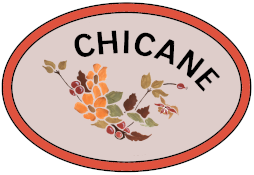
EDITORIAL
Issue No. 85 and into the 15th year! In the August 1991 issue, two years after it all began, the question asked was "Where is the summer this year?" Not a good year, but two holiday pictures drawn by Lloyd Gove and Ashley Lane - from the Primary School- gave us a cheerful and sunny cover. I wonder what Lloyd and Ashley are up to twelve years on?
This summer, however, we cannot complain and what a beautiful weekend we had for the first Open Garden Trail - let's hope that the weather for the second on the 3rd of August will be as good.
Sadly, due to end-of-term pressure and Ofsted looming, there are no contributions from the Primary School, but we look forward to hearing from them in October. In the meantime, we hope all pupils and staff have a relaxing and enjoyable holiday and wish good luck to those pupils moving on to secondary education and the new ones starting their school years in September.
Items for the October issue will be needed by the middle of September please, either to me direct or via the Post Office, and again I must thank everyone who has made this another very full and interesting Newsletter.
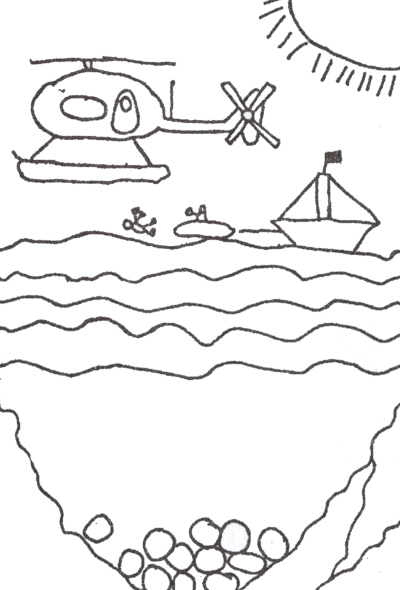
Lloyd Grove

Ashley Lane
Ed.
1
THE GERMAN SHEPHERD DOG
For many centuries, ancestors of the Alsatian or German Shepherd Dog were used to herd and guard sheep. During the First World War, the Germans trained these dogs to act as messengers and to locate the wounded. Recognising their worth, soldiers from the allied forces returned home with dogs of this breed. Its popularity had spread worldwide by 1926, but its reputation of reliability had suffered due to indiscriminate breeding. However, in recent years it has recovered its rightful place as one of the most versatile and popular dogs in the world.
The coat, which is hard, close-lying and weather resistant, comes in a variety of colours - most commonly black and tan. Owners need to be committed, especially to early training and regular exercise. The German Shepherd is often used as a 'working' dog for its owners and certainly makes an excellent watch dog.
Thank you, Debbie, for illustrating this highly intelligent, responsive and popular dog the 6th in the series - for the cover this month.
2

BERRYNARBOR W.l.
At our June meeting, Graham Andrews - Chairman of Berrynarbor Parish Council - gave a most interesting account of the work and history of Parish, District and County Councils. Graham has been involved in this work since 1967 and has obviously enjoyed serving the community in this way. The vote of thanks was given by Win Collins, the raffle won by Di Hillier and the competition for a cuddly toy won by Win Collins.
In July our meeting was addressed by Viv Blackman who advised us on making a mosaic for the Manor Hall. Viv has already produced a mosaic for Berrynarbor Primary School garden, with the help of the children, and has offered to help us with our mosaic. Making one will involve teamwork and groups can work on different sections, so if anyone is interested and would like to come and help, please contact Doreen Prater or Marion Carter. We then all enjoyed taking part in competitions arranged by Margaret Andrews and Linda Brown. A special presentation was made to Ethel Tidsbury as she will be 90 this month. The raffle was won by Joan Wood and the competition for four small cakes by Linda Brown.
Members are looking forward to a visit to Chambercombe Manor on the 15th July, and as we do not have a meeting in August, our next meeting will be on Tuesday, 2nd September when Doreen will tell us about her Canadian experience. So, ladies, do please come and join us.
Marion Carter
3

IN MEMORIAM
PREB. ANDREW JONES, 1922-2003
It was with great sadness that we learnt of the death of Preb. Andrew Jones on the 22nd May. Our love and sympathy go to Heather, Mark and Hilary.
St. Peter Ad Vincula church was full for the Funeral Service on the 29th May, and again for the Memorial Service on the 15th June.
We shall all miss Andrew for his enthusiasm, sensitivity and kindness and we know that he loved coming regularly to Berrynarbor during his 'retirement' - in fact the last Holy Communion Service he took was at St. Peter's when I had the privilege of acting as Server. Heather, too, has many happy memories of Berrynarbor and we always appreciate her help when deputising as our organist.
In a long and faithful Ministry in many parishes, Andrew was always inspiring and encouraging. He would want us to remember him for these qualities.
"May the souls of the faithful rest in peace, and rise in glory."
Margaret Andrews
REMEMBERING
Winifred Lucy
Barten
'Lucy' - 1911-2003

A grand old lady has slipped away to be reunited with her dear husband, Richard. They had been together for nearly 70 years and she never got used to being without him when he died four years ago.
She looked tiny and frail, but her heart was strong. She was an active, athletic, beautiful woman - an Essex girl, as the Rector pointed out! Although I cannot remember seeing her in white stilettos, I do remember her vividly in white tennis and badminton clothes, in shorts and T-shirts running for her County - winning many cups and trophies - in long, floating ballgowns she had made herself [she loved to party!] and in Lydford's big farmhouse kitchen cooking wonderful meals for her family and farm workers, who all gathered around the long table at harvest, sheep shearing and all highlights of the farming year. She was an accomplished pianist and needlewoman - many people around the village will have won or been given samples of her embroidery and patchwork.
Yes, as my brother said, 'She was young once' and had many a tale to tell. She didn't take kindly to getting old and became very impatient with me when I couldn't keep up with her walking around Bicclescombe Park last year. I was so lucky to have had my mother for 63 years and I keep going to tell her or ask her something - I have run out of the marmalade she used to make and my mending is piling up - she always did that for me oh, endless things she quietly did which I now miss.
Thank you, Rector, for such a simple and moving Service, 'Lucy in the sky like Diamonds' was a lovely touch, and the story of the chrysalis turning into a butterfly really helped the children to understand that although we were sad to say 'good-bye', we were also happy she was back with Dad again. We sent her on her journey to the resounding music of 'Chariots of Fire', a most fitting tribute to my athletic Mum.
John, David and I thank you all for the cards, flowers and donations to Berrynarbor Church.
Sally Barten
Angela Richards
'A Friend Called
Angela'
I guess it must be over forty years ago that I first met Angela. My parents had moved to Berrynarbor and anxious to get to know a few more people, I joined the Berrynarbor Village Players. Angela came along and introduced herself as 'a farmer's wife' and I remember thinking what a lucky fellow the farmer was to have such a pretty, young wife.
Shortly after that I went to work in America, but only a few years later our paths were to cross again. Now married and settled in llfracombe myself, both Angela and I became members of the newly formed llfracombe Ladies Circle. For the next fourteen years we saw one another on a regular basis, not only at LC meetings, but at all the coffee mornings, good as new sales and other charitable and social events in which Circle was involved.
In 1981 I left to live and work in West Africa and so began a 20-year period of correspondence between us - we shared highs and low, births, deaths, marriages and divorce, local gossip, all on paper. There was enough sent back and forth over the years to produce the most interesting of 'soaps'! Angela had a distinctive hand, and I doubt she ever realised my delight on opening my PO Box and discovering a letter from Berrynarbor. Occasionally I would make sojourns to the UK and always tried to see Angela, if only for a half hour chat over coffee. We had that camaraderie of true friends, the ability to pick up where we had left off last time, albeit there could have been a two or three year gap between our meetings.
The last time I saw her was in November 2002. I had recently taken up residence in France and was making a flying visit to Taunton for a family birthday. However, knowing that Angela was poorly, I managed to fit in a day trip to 'combe, and Angela and Judie joined me for lunch at the Landmark. I was not prepared for the deterioration in her health and as I gave her a welcome hug, I was aware of what a frail being she had become. But it wasn't long before we were settled and she was telling me all the latest news and obviously relishing in the newest family member, her granddaughter Elyse. Angela's appetite was poor, all she wanted for lunch was a bowl of soup, but I teased her to pinch some of the large mound of chips I had been served and she duly obliged, giving me that wonderful, wholesome gap-toothed grin of hers. The smile lit up her face and I was immediately reminded of that pretty farmer's wife I had first met forty years before.
The life I witnessed in Africa, or more importantly the hundreds of unnecessary deaths I was aware of, have, I'm afraid, dampened whatever religious beliefs I may have clung to. So how does one gain comfort from the loss of a dear friend? It's hard, but I have come to realise that of all the billions of people that populate this planet, a very small percentage were close enough to be her friends, and I was lucky enough to be one of those few. Her memory and her smile live on in our hearts.
Susan Paul
Moules Farm

Following Angela's death, Sally, Dave, the family and I have found much comfort in the many cards and messages of sympathy we have received. The support of so many people at the Celebration at St. Peter's Church and afterwards at the Crematorium was much appreciated, and a sum of £500 has been sent in Angela's memory to the British Heart Foundation.
Thank you for your care and thought, and with my very best wishes,
Norman
4

ST. PETERS CHURCH
The bells rang out in welcome and the church was almost full for the Christians Together Service on the evening of 22nd June. After an hour of hymn singing, interspersed by accounts of the various stages in John Wesley's life, everyone was glad of a cup of tea in the Manor Hall. Our thanks go to the ladies who baked cakes for this special occasion.
Gift Day yielded £843 this year [over £100 more than last year]. Thank you all for your generous gifts and for coming along on the day - the Rector and members of the PCC were, as always, glad of your company.
We are looking forward to the Summer Fayre on Tuesday, 12th August, 6.30 p.m. onwards at the Manor Hall. Items for prizes and the various stalls will be most welcome - please ring Mary Tucker [883881] if you would like anything collected and please don't forget to come along and support us on the day!
To turn to September ... the Harvest Festival will be held on Sunday, 28th September and gifts of flowers, fruit and vegetables for decorating the church will be very welcome. The Supper will be held in the Manor Hall on Wednesday, 1st October. Please look out for posters giving details nearer the time.
Friendship Lunches at The Globe will continue through the summer and the next two will be on Wednesdays 27th August and 24th September. If you are new to the village and would like to join us, please give Mary Tucker a ring [883881] in the first instance.
Mary Tucker
5

SUNDAY SCHOOL
Summer Holidays are here, we finished last Sunday at the Teddy Bears' Picnic, the Rector leading the children around the church with their sea-faring bears. The Rector had drawn symbols, including the fish to explain how in those days one had to keep their Faith secret, unless you didn't mind having your head chopped off! Why do children enjoy a bit of gore? That piece of information certainly went down well, as after church, one or two thought it a splendid idea to de-capitate all Sunday School teachers!
Now, with Sarah's artistic flair and imagination we shall be building our float for the Carnival - we have enough cardboard now, so thank you to all those who have given so generously! Come and cheer us on at the Carnival procession in Combe Martin on 13th August.
The Church Fete is on 12th August. If you have any children's toys or books, etc., to sell, please let me know on 882746. Funds raised will go towards better lighting in the church - Stuart does find it difficult playing the organ, especially when he is showing off using both hands and holding a torch! Anyone got a miner's helmet?
Val, Sarah, Julia, Juliet and myself are looking forward to a rest and the children are looking forward to a break from us! Next term begins on 7th September in church for the Family Service at 11.00 a.m.
Believe it or Not! A young missionary served in a remote part of Africa with few resources. But he did manage to convert some of the natives. One day, unarmed, he was walking through the bush when he was confronted by a lion. He knelt in prayer, hands clasped and after a few moments opened one eye and saw that the lion, too, was kneeling down and had his paws clasped. "My goodness," said the missionary in relief, "Are you a Christian too?" "Yes, I am," the lion replied, "l was just saying Grace."
Sally Barten
6

BERRYNARBOR PRE-SCHOOL
We currently have vacancies in our sessions on Monday, Tuesday [additional day], Wednesday and Friday, 9.00 a.m. to 12.30 p.m., at the Manor Hall. We are a small, parent-managed group, able to offer each child individual attention from our qualified staff. There are indoor and outdoor play facilities.
For further information or to arrange a visit, please ring Katie on 862675 or Julia on 882783.
7
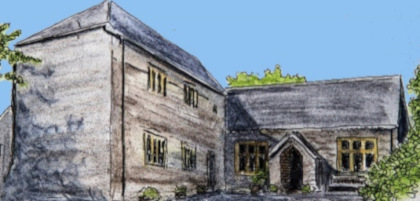
MANOR HALL MANAGEMENT COMMITTEE
A reminder that the Berrynarbor Horticultural and Craft Show will be held on Saturday, 6th September. Schedules and entry forms will be available from the Post Office, Glenbridge and Devon Cottage from mid-August.
Anyone can enter and there is no fee, so the more classes you enter, the better your chances are.
When the Hall is full of exhibits, it makes a splendid sight, so please show us the best you have got! Weather is no excuse for flowers and vegetables - we all suffer the same. And for the art and craft classes, there is still time!
This year is a departure from previous years and entries will be accepted into certain classes from individual children and judged according to age.
Finally, to those who won cups and awards last year, please let me have them back before the Show, even if you do think that you might win again!
John Hood
8
SEA-FEVER
John Masefield 1878-1967

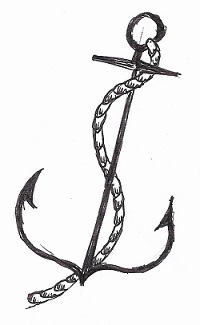
I must go down to the sea again, to the lonely sea and the sky,
And all I ask is a tall ship and a star to steer her by,
And the wheel's kick and the wind's song and the white sail's shaking,
And a grey mist on the sea's face and a grey dawn breaking.
I must go down to the seas again, for the call of the running tide
Is a wild call and a clear call that may not be denied;
And all I ask is a windy day with the white clouds flying,
And the flung spray and the blown spume, and the sea-gulls crying.
I must go down to the seas again, to the vagrant gypsy life,
To the gull's way and the whale's way where the wind's like a whetted knife;
And all I ask is a merry yarn from a laughing fellow-rover,
And quiet sleep and a sweet dream when the long day's over.
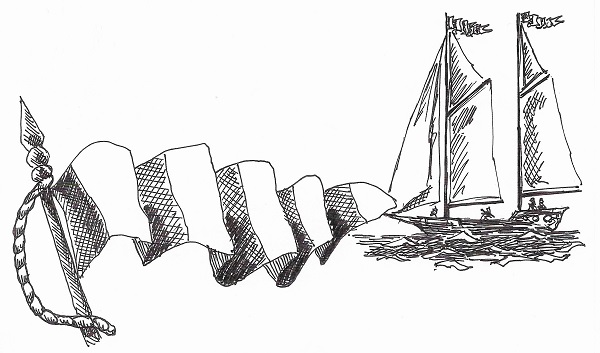
Illustrations by: Paul Swailes
9
GET WELL
It is great to be able to welcome Ivy home after her mammoth stint in hospital - first in Barnstaple and then in llfracombe - seven months in all! It is also good to report that Ted Lane is home again, although his hospital visit was not quite so long. We hope that now they are back in Berrynarbor, the 'getting well' process will continue.
Vi Kingdon remains at the Tyrrell Hospital, but a move to a 'care home' may be on the cards. We send her our love and very best wishes, as we do to Sid Russell, whom we understand has had a fall and is now in hospital. We hope you will soon be back again at Pinehurst, Sid. And our best wishes to everyone currently unwell.
P.S. Sadly, since writing the above we understand that Ted has returned to hospital and we send him our best wishes.
10

WEATHER OR NOT
For a change we have decided to compare May and June's statistics with the average for the same months over the previous three years. These figures are in brackets.
Starting with the rainfall - the total for May was 80mm - 3 3/16" [106mm - 4 1/4"] while in June we had only 50mm or 2" [59mm - 2 5/16"]. The total rainfall for the first six months of the year was 440mm - 171/2" [700mm 27 3/4"]. It has been a dry start to the year.
May's temperature ranged from a low of 3.6 Deg C on the 15th [low 3.9 Deg C] and a high of 30 Deg C on the 30th [high 27 Deg C]. June had a low of 7.7 Deg C on the 13th [low 6.3 Deg C] and a high of 29.2 Deg C [high 29.1 Deg C]. The wind speeds in May reached 31 knots [28 knots] and in June the highest gust we recorded was 23 knots on the 10th and 18th [26.3 knots].
As you can see from these comparisons, apart from May being drier, the months have not differed significantly from the last three years' averages. The biograph charts for May and June show fairly steady pressures with a low of 1003mb on 30th June and a high of 1027mb on 20th June. Chicane's sunshine records for May and June show a total of 131.64 hours and 172.12 hours respectively, which seems quite good to us though we have no records with which to compare them.
We are writing this report at 10.00 p.m. on the 14th July [trying to catch the deadline!]. It has been the hottest day of the year so far and the outside temperature is still 22.3 Deg C, but more about this in the next magazine!
Sue and Simon
11

MATCHED
On the 31st May, our daughter Isobel was hitched at St. Peter's church, Berrynarbor, to Captain [Church Army not Navy, as some had supposed] Paul Tyler, who came from his Huntingdon Parish with a fine crowd of friends and relatives to enjoy the most perfect country wedding. The sun shone, birds sang, bees buzzed, the ringers rang and the bride blushed on cue at the Vicar's merry quip [you know, the wedding one]. No one having accepted his kind offer to step forward and give reason to object before it was too late, our gifted friend Marilyn sang gloriously. The Manor Hall, like the church, had been beautifully decorated with flowers by friends in the village, whilst others had prepared a most splendid line of dishes for guests at the reception. To those people who worked so hard and generously, we give our deepest thanks. They enhanced an already happy occasion with their skills.
Paul endeared himself to us by only speaking briefly in response to the toast to bride and groom, but notably failed to apologise for not producing the five fat kine demanded from him as a bride price.
In the evening we danced to a local folk band and were delighted by the number of people who were able to join us and help our new friends from Huntingdon feel even more welcome. Many said that they were so impressed with the village that they will be sure to come again on holiday.
Isobel and Paul now live in a vicarage in the middle of the parish where he works and she is learning what it means to be a parish wife. Always busy! She says that after the hills of Devon, the flat country of Cambridgeshire takes some getting used to, but they both hope to come back again, even if only for a short visit.
Peter H.
Isobel and Paul, our congratulations and we wish you both every happiness in your future together.
12
JUST A PERFECT DAY
The Gardens open on Sunday 13th July were just perfect - weather, cream teas at Ken and Judie's and comments from visitors included: 'wonderful gardens', 'friendly village', 'nice to get together'. Our thanks must go to those who opened their gardens, sold programmes, and Ken and Judie and their helpers who were kept busy throughout the afternoon.
Berry in Bloom: National Judging Day - Tuesday, 5th August
13

WELCOME AND FAREWELL
After finding the web-site for Berrynarbor Park and checking out the opposition, Chris and Jenny Caswell decided to replace their Bristol home for one here in Berrynarbor, No. 37 Berrynarbor Park, arriving at the end of June.
Having retired three years ago from chocolate production with Cadbury's, Chris and Jenny, who has recently retired as a Sales Assistant with the House of Fraser, plan now to continue their hobby of walking, particularly the coastal paths.
They have two children - daughter Sheryl who lives in Brighton, and son Matthew and his wife, who live in Bristol.
Chris and Jenny look forward to becoming part of the village and have already taken part in the Open Garden trail and the Musical Evening at the Manor Hall. We wish them a happy retirement and good luck and joy in their new home.
After Channel-hopping over the last few years, Jenny Taylor has decided to make her 'almost permanent' home in France. At the end of July, Le Bois Belloir, Montreuil l'Argille in Normandy is to replace her home at Goosewell. Jenny will not be severing contact completely, as she will be returning to visit her mother and family.
Jenny, we wish you every happiness in your new home and thank you for all that you have done for the village, particularly your years on and Chairmanship of the Parish Council and your Governorship of the Primary School.
No. 6 Goosewell will be home to Rob and Gill Lomax and their dog, Meg. Rob's line of business is hotel management and Gill is a teacher. We extend a very warm welcome to you both and hope that you will enjoy living here in Berrynarbor.
14
THE FLIGHT OF MON 2941
The End to a Perfect Holiday
This Easter, my wife and I had spent another very enjoyable holiday in and around the Indian state of Goa, and were not looking forward to the tedium of the long journey home before going back to school. If all went to plan, we should land in London before midnight, giving us just enough time to get to our car and drive back to Devon in time to get ready for school. Little did we know that our expected eleven hour long trip was going to turn into a thirty-three hour epic...

I was sat in the departure lounge at Dambolin airport straining to hear our flight being called over the public address system, battling with the sound of many raised voices. We were already an hour late, not an uncommon occurrence on flights from India in our experience and I began my calculations: would we get back in time to drive from Gatwick and be in school by 8.15 the following day? Our flight, the very last charter of the season, was eventually called and with relief I left the feted atmosphere of the terminal building. The ceiling fans could hardly stir the air thick with the smoke of cheap duty-free cigarettes, consumed avidiy by those addicted before the four hour fifty-five minutes flight to our refuelling stop at Baku in Azerbiajan.

This first leg of the flight went without incident until moments before we touched down to refuel. The captain interrupted the in-flight entertainment: "This is your captain speaking." Yes, he really did say that. "We are about to make our scheduled landing to take on board fuel, re-cater and change crews at Baku for your onward journey, but I am sorry to tell you that the authorities there are refusing to allow you to disembark due to the possible threat from SARS." [During our two week stay in Goa, India had reported three confirmed cases and therefore the level of precaution was raised.] "You will, therefore, have to remain in your seats for the duration of the stopover. The airport should be pretty quiet at this time and I would hope refuelling will only take about forty-five minutes, and then we can have you on your way as soon as possible."
Forty-five minutes turned into an hour and a half, but finally, almost two and a half hours behind our original schedule, we took off on the five and a half hour leg to Gatwick. My calculations were now at a critical point!
I sat and day-dreamed. A glass of red wine in one hand, a packet of Mini-Cheddars in the other. I watched the in-flight entertainment - Only Fools and Horses - and promised myself a walk to the toilet after this episode, to stretch my legs. Suddenly the video screen went blank and my headphones cut out. These things happen, so nobody seemed unduly concerned. Then the captain simply said: "Cabin crew codeword bravo." At that two things happened simultaneously. The cabin crew stopped their rounds with the drinks trolley and immediately went into what seemed a well-practised emergency routine, retaining their fixed smiles. They covered all the doors, pressed buttons and consulted manuals. The passengers began to stir. Most of the 320 of us on board were in pairs: husbands and wives, couples or just friends. Few words passed between us, but the atmosphere was one of concern and uncertainty. We were getting no information, the plane continued in level flight, but clearly all was not well.

Nothing happened for ten long minutes and then the captain, this time in a somewhat strained voice said: "Ladies and gentlemen, I am sorry to have to tell you but we have a technical problem with this aircraft. The smoke sensor in the forward luggage hold has gone off". [You could hear an audible warning in the background.] "This has activated the automatic fire extinguishing system. I have, therefore, been forced to turn round and we will be making an emergency landing at Baku in about twenty minutes."
The atmosphere changed again. Whilst there was not outright panic, the level of tension was certainly heightened. People were not talking. People were worried, a lack of hard facts and our imaginations saw to that. Eventually we began to descend. I expected to land but the plane made a low pass over the airport and then rose and circled before coming in for a second time. I was concerned at this, but subsequently discovered this was standard procedure to allow emergency crews on the ground to visually inspect the aircraft for obvious signs of damage. We touched down in a remote corner of the airport, away from the buildings and other planes. Firetenders and other emergency vehicles were waiting, their blue lights flashing in the dark. Doors were quickly opened and steps brought up. The cabin crew marshalled a speedy but orderly exit and we were bussed away from the aircraft.

After about forty minutes waiting on the tarmac and despite our emergency, we were still deemed a SARS risk and thus had to be segregated from others. We were taken to a cleared area of the terminal building and there we sat on the floor covered by our airline issue blankets. We waited, and waited - some people talked, some drank, others added to their duty free allowance and one man even busied himself making notes and phoned the Daily Mirror with a scoop: "320 tourists stranded in Azerbiajan due to fire in jet engine." You really see all sides of humanity at times like this.
After about two hours, the captain entered the room and spoke somewhat unconfidently through a megaphone. He said the engineers had gone over the plane and could find no reason for the sensor going off. There was no fire in the hold. He went on to explain that there was no accommodation for us in Baku and no chance of getting a relief plane before Monday at the earliest. He was, therefore, proposing putting us back on our plane and continuing the journey to Gatwick but without our luggage. He explained that although the plane was safe, regulations dictated that the hold must remain empty since firstly they did not know why the sensor had been triggered and secondly, the automatic fire extinguishing system could not be reset as no spares were available in Baku! The luggage would remain in Azerbiajan and be freighted out on the next available plane. These suggestions certainly did not meet with universal support. There was vocal opposition in many quarters: some doubted the safety of the plane and others feared their luggage would be pray to looting. It therefore took a further two hours to persuade everyone that there was no alternative and to ready the plane for departure. My calculation was now well and truly in deficit! We sent a text message to our son asking him to inform the school of our predicament and to explain we would not be back in time to teach on Monday.

We took off and flew the five and a half hours back to Gatwick. Despite a little clear air turbulence and a lack of hot food [much to the displeasure of one passenger!] it was thankfully an uneventful journey.
We landed in the small hours of the morning and were ushered quickly through Customs to the empty luggage reclaim area, where we had to fill in forms describing our luggage and its contents before we were allowed to leave. We walked out into a cold, wet dawn and drove home.
There is a postscript to this story. Firstly, just two days later our luggage was returned to us, complete and unharmed, by London taxi, just as promised. Secondly, and more profoundly, people have asked me if the experience has put me off flying, and the answer is 'No'. It is 'no' for two reasons: one I have flown since I was a child and I have never encountered a major problem before; two, I asked one of the cabin crew if they had ever had an incident like this before on one of their flights. "No, not in ten years." she said. They say you are more likely to die by being kicked to death by a donkey than in a plane crash! Air transport is the safest way to travel and I expect never to be involved in an emergency again.
Words and Illustrations: Paul Swailes, 2003
15

BIKERS OF BERRYNARBOR
The longest day, 21st June, saw a group of riders leaving at 7.00 a.m. for a ride of about 100 miles and a good breakfast en route. We crossed Exmoor on this lovely sunny morning, passed through Wiveliscombe and on to Bampton, South Molton and Barnstaple, where we indulged our appetites. This event was enjoyed so much that, by popular request, we are doing another one on the 2nd August.
An evening ride on the 9th July took us to Minehead for a 15-minute stop, then on to Exford for refreshment at the White Horse. Again we were blessed with a wonderful evening and we all enjoyed ourselves immensely. We hope that some holiday riders will join us in August for our two planned rides [on the 2nd and 6th], and also look forward to the International Classic Scramble in mid-August.
Brian
16
EUROPEAN CHAMPIONSHIP
The North Devon [Atlantic] Classic Motorcycle Club will be host to the fifth and final round of the European Championship during the week-end of 16th and 17th August. This Scramble will feature some 150 of the very best Classic Scramble Riders, with about a third of them coming from the Continent.
The two-day event will take place at Sloley Park, by kind permission of Derek Phillips, and will start at 12.30 p.m. on both days. Entry for spectators will be £5 per day, with kids going free. There will be refreshments and licenced bar, a bouncy castle and other entertainment.
So why not make it a family day [or days] out and join in the excitement and spectacle of this 'thrills and spills' international event being held on our doorstep?
17
OF THIS AND THAT...
Laundry
A reminder that a coin operated commercial washer and tumble dryer are available at Berrynarbor Park for any villagers wishing to avail themselves of these facilities. For more information, please contact Paul or Theresa on 882631.
Wine Circle
A good BBQ was held at Tower Cottage, despite the fact that for a short time it came on to rain.
Thanks to Keith Walls for fetching a table umbrella and Alan Rowlands for providing an extra and new gazebo, which with helping hands was quickly erected, prompting the rain to stop from that point on! Alex Parke, our Chairman, has arranged a repeat visit to Camel Valley Vineyard, near Bodmin, on Friday, 29th August, which is now fully subscribed, with over 30 members and friends wishing to participate.
Trans-Send
At the meeting on 2nd July, Malcolm Shepherd, Managing Director of Wessex Grain - an expert in bioethanol fuels - spoke on the topic "Transport Fuels from UK Cereals". He spoke about bioethanol production and of the help other governments were giving to encourage it. Wessex Grain are hopeful that through their continuous efforts at lobbying, etc., there could be a UK plant in the South West by 2005.
After a break, the next meeting will be on Wednesday, 1st October, 7.15 p.m. at The Lantern. The subject will be "Hemp".
Bonfires!
Please think of your neighbours when you need to set fire to the garden rubbish. It can be very unpleasant on a nice sunny afternoon or early evening, to be 'smoked out'. Please delay your pyromanic enthusiasm!
Our Voice on Devon County Council [Combe Martin Rural]: Mike Knight, M.A. Tel: 882692, e-mail mhknight@devon.gov.uk. [Liberal Democrat)
Advance Notice: Soldiers of the Great War, 1914-1918
Memorial Exhibition and Workshop at Combe Martin Parish Hall on Saturday, 8th November, 10.30 a.m. to 6.00 p.m. Refreshments in aid of Church Funds.
Focus on War Memorials in Combe Martin and Berrynarbor. A hands-on family and community History Day with the aid of Researchers and Millenium Award winners.
How did YOUR village cope through WWI? Is YOUR family name on your War Memorial?
Congratulations to our three new nonagenarians: Betty [Dudley-Ward] who celebrated her 90th birthday at the end of June; Ethel [Tidsbury] who celebrated hers in July and Daisy [Carter] who will be celebrating her birthday in August., Our very best wishes to you all.
19

THE COMMON CORMORANT
Christopher Isherwood 1904-1986
Lays eggs inside a paper bag
The reason you will see no doubt
It is to keep the lightning out.
But what these unobservant birds
Have never noticed is that herds
Of wandering bears may come with buns
And steal the bags to hold the crumbs.


Illustrations by: Paul Swailes
20
PRIDE BEFORE A FALL
The Peacock was sure that his beautiful tail
Would captivate every drab little female
He spread and preened it
Admired and cleaned it
He dreamed of soon having his very own harem
What fun it could be to pick them and choose them
Just look at my tail
My own holy grail
Those poor little Peahens so brown and so boring
Are surely all longing to do some adoring
To gaze at my tail
My beautiful tail
Arrayed in his glory he strutted his stuff
No thought in his head of any rebuff
With feathers like this
I'm guaranteed bliss
Now here she is coming my first little wifelet
Perhaps I'll be kind, give her nought to regret
I'll show her my plumes
She'll come to my rooms
He checked on his tail, his wonderful tail
Then gazed at the sky to let her grow pale
To fall at his feet
As was only meet
But oh what a turn off these show offs can be
Too pretty by half for you or for me
Oh dear what an ego
I just have to say...
Jenny, Middle Lee Farm

"What do you mean, no?"
Illustrated by: Debbie Rigler Cook
21

DREAMWALK
In August 2003, the skies above North Devon will light up as the Castle Hill Estate becomes the stage for Dreamwalk. 100,000 dazzling lanterns and torches will light the way for our audience as they embark on an illuminated walk of discovery. Hundreds of performers, a medieval battle re-enactment, a spectacular fire and water finale and some amazing scenery will make this one of the most spectacular events ever staged in the South West.
DREAMWALK IS NOT JUST AN EVENT ... IT IS AN EXPERIENCE
Lightquest events are designed to bring an open-minded audience out into the countryside at dusk and into the night. Dreamwalk gives a choice of two illuminated circular trails - the Discovery Route for the family and the Explorers Route for the keen walker [both take around 3 hours to complete]. The walks are outdoors and partly cross-country, so please wear sensible footwear, practical clothing and bring a torch. The grounds of Fortescue Estate at Castle Hill are not normally open to the public and this is a unique opportunity to see the grounds as they have never been seen before.
Bank Holiday Saturday and Sunday. 23rd and 24th August 2003
Castle Hill, Filleigh, Barnstaple. Free parking available.
Book early - last year's tickets sold out within 4 weeks! Tickets - £10 for adults, £5 for kids or £25 for a family, available from the Queen's Theatre and the Landmark Theatre, 01271 32424 All profits go to the North Devon Hospice "Light in the Dark" Appeal which aims to raise £2.2 million to build a bedded in-patient unit at the Hospice for the people of North Devon.
Join us for Voices for Hospice 2003 and 'Pay to Sing' Handel's Messiah
Every 3 years, Hospices throughout the world perform a musical event on the same day at the same local time, in order to raise funds, awareness and support for their work. On Saturday 4th October, for Voices for Hospice 2003, the North Devon Hospice plan a performance of Handel's Messiah at the Church of St. Peter and Mary Magdalene, Barnstaple, at 7.30 p.m. Supported by the Royal School of Church Music in Devon, Mr. Andrew Millington, Director of Music at Exeter Cathedral, will be the Conductor and Musical Director, Mr. Shaun Tucker of Wimborne Minster will play the organ and soloists will visit from the Royal Academy of Music in London.
We invite you to pay to sing this well loved classic and are seeking as many choirs and individuals from across North Devon to participate in the chorus on a 'pay to sing' basis at £5 per person [a light supper is included]. If singing isn't your forte, be part of the audience and tickets are available now for £5 each. All proceeds to be donated to the North Devon Hospice Light in The Dark Appeal.
Do come and join us for what will be a truly elevating event! Simply telephone the Fundraising Office on [01271] 342242 to secure your 'pay to sing' place or order your audience tickets.
22
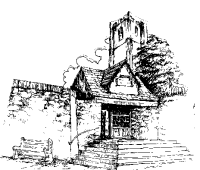
LETTER FROM THE RECTOR
The Rectory
Combe Martin
Dear Friends,
It might seem a rude question, but 'What do you take with you when you have a bath?' I know some people take soap, or cleansing gel, some even take a flannel or a loofer or even a pumice stone. Children have even been known to take a rubber or plastic duck, a boat even, and some a boat and a submarine! Some adults have even been known to take flippers, a wet-suit and even an aqua lung with a spear-gun! But that was Mr. Bean!!
When we witness to the love of God, we don't need lots of 'extras', we just need ourselves and God's grace. We don't need a lot of baggage, just ourselves and Him. Our experience of God's love is all we need to help bring in God's kingdom here on earth by sharing His love with others.
We show God's love when we are courteous to others, even strangers or visitors, and it is surprising what a warm welcome is created by just saying "Good Morning" to the people we meet. But there again, you knew that anyway, didn't you!
With all good wishes,
Your Friend and Rector,
Keith Wyer
23
WORLD'S BIGGEST COFFEE MORNING
26th September 2003, in aid of Macmillan Cancer Relief
This annual event throughout the country last year raised £3.2 million and through the support of the village, over £250 was contributed for the Macmillan nurses at North Devon Hospital. This year we hope you will come again! It will be held in The Globe, between 9.00 and 11.30 a.m. in the function room. Again we hope to sell Christmas Cards for the Children's Hospice, the North Devon Hospice and also Macmillan Cancer Relief.
£100 has already been donated by the same generous person as last year for the first prize in the raffle, and we shall have another fun pictorial quiz, posted around the room to pit your wits at your leisure. Please call in, perhaps after dropping the children at school, whilst waiting for the bus to town or just support the cause, after all so many of us know of someone with cancer and every day 732 people are told they have it. All the money raised on the 26th is donated to the local fund at our hospital in Barnstaple. Look forward to seeing you.
Diane Lloyd and Judy Hand
PS - If you would like to offer a raffle prize please call me on 882424. 52 prizes were donated last year and were very much appreciated.
24
CROSSWORD SOLUTION

25

YOUR POST OFFICE
The school holidays have arrived and with them the very welcome holidaymakers. Already we have seen a much needed up-turn in business and as a consequence have initiated a small section for local products and hope to soon stock organic items as well. So please do ask about them if you're interested, as this will help us to identify the demand.
We opened our garden for the Village Tour and were very pleased when all went well on such a superbly warm and sunny day. We're looking forward now to Tour II, when we can visit other people's gardens in return.
We are sorry to be losing our assistant Jane who understandably wishes to spend more time, especially in the holiday, with her family. We're quite sure she will be missed by customers and well as by ourselves.
Alan and Nora
26
MEMORIES
West Moory
Combe Martin
I read with much interest Lorna Bowden's article in the Newsletter, also Ron Toms' account of his life and work on the Barton Farm. I lived with my grandparents for the first eleven years of my life at Hammonds Farm, and so always look upon Berry Narbor as my home village and often walk around the area with a friend of mine.
Often, when walking along the Sterridge Valley, I point out the houses and tell her of how my grandmother would take me visiting the people who lived in them. On one such occasion she turned to me and said, "Alvina, I envy you for you are so lucky to have 'roots' in this lovely county."
I often think of her words and realise how true they are, so when reading the Newsletter what fond memories for me it arouses. Thank you.
Alvina Irwin [nee Richards]
Thank you, Alvina, for your letter and for agreeing to share some of those Memories with us in the October Newsletter.
27
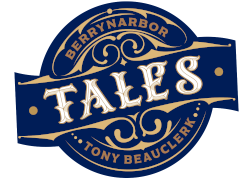
GOSSIP!
Upon leaving our house, if you turn left there is a bus stop a few yards down the road, and if you turn right there is a post box, again just a few yards away.
As I set out one day to catch a bus into Colchester, I heard a loud voice call out.
"Hello, Tony, I'm just going up to the post."it was my neighbour, Mrs. Rettcha.


"I must tell you this," she continued, "You know our Ben has had an accident? Well, when he went into the A & E he was seen straight away, but the funny thing was that he met an old flame. She's married now of course, with three children. Been married before, of course. Her present husband has too. They had just come back from Australia. She looked very brown. I said to Ben, 'You'd better look out, she might be after you again.' Not that I would mistrust him, but you never know do you? By the way, I bumped into Fred the other day. You know, the one with the big nose. He's had a boil, you know, nasty things, very painful. I said to him, You do look poorly.'
He said, 'Yes, I feel rotten.' I said, 'Go home and make yourself a nice cup of tea.' 'You won't tell anyone about my trouble will you?' he said, and I said, 'My lips are sealed'. He gets embarrassed easily, that's why I keep quiet about these things. Oh, I must tell you this. I saw your granddaughter snogging with a lad in town on Friday, in a shop doorway. Didn't like the look of him. He might be alright though, you never can tell these days. Hasn't she grown? She must be about fourteen now. Shouldn't worry if I were you."

I thought 'What a comforting sort of person this is'! She prattled on for another ten minutes about the rather unpreferred side of our world, then looked at her watch and said, "There now, if you hadn't kept me talking like that I wouldn't have missed the post."
Never mind that my bus had long gone. Do you know, I really enjoyed the walk into town and I think it did me good!
By the way, did you get the anagram of Rettcha? Chatter!
Tony Beauclerk - Colchester
28
A RARE BUTTERFLY IN THE STERRIDGE VALLEY
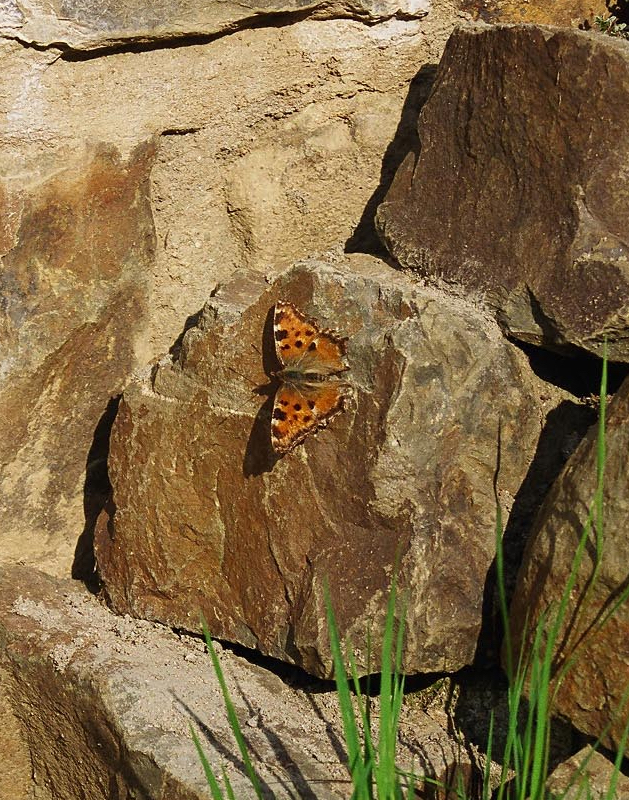
Large Tortoiseshell Butterfly at Harpers Mill, 17th April 2003
We have been recording all kinds of wildlife in our garden at Harpers Mill over the past two years. On Maundy Thursday [17th April] this year, as we stood at the top of our drive waving off some visitors, a butterfly flew past that we immediately recognized as something different. Fortunately, it settled and basked in the sun on our rockery, allowing a careful approach to within 1-2 metres but always flying off fast and strongly if approached too closely, before returning to a sunlit area. We identified the butterfly as a Large Tortoiseshell, a distant relative of the familiar Small Tortoiseshell, that we recognised from time abroad, but knew to be very rare in this country. Fortunately, we were able to take three photographs at pretty close range, which have proved good enough to confirm the sighting. After basking for some minutes, the butterfly flew off down the valley.
The Millennium Atlas of Butterflies in Britain and Ireland, published in 2001, shows how Large Tortoiseshells used to be quite widespread but declined in the 20th century to become officially extinct as a breeding species. The Atlas says: "The few genuine sightings in recent years are thought to be mainly of individuals that have been reared in captivity from larvae obtained abroad and that have either escaped or been released into the wild". It also shows that the last record of Large Tortoiseshell in the Berrynarbor area was more than thirty years ago. We sent details of our sighting, along with the photographs, to the Devon branch of Butterfly Conservation, which featured the butterfly on the front cover of their county newsletter. The record is also being submitted, through the Devon Butterfly Recorder, to the Devon Biological Records Centre.
This was the first sighting of a Large Tortoiseshell in Devon for many years. We'll never know if it was a truly wild migrant from the continent, one which hibernated over the winter, or a butterfly that was bred and released in the UK. Interestingly, as everyone will recall, the week before Easter was unusually sunny, which may have played a part. Whatever, its appearance in our garden was very exciting and goes to show just what can turn up when you garden with wildlife in mind. In the last six months alone, we have recorded more than 150 different kinds of moth - many of them very striking and colourful. More about them in a future issue!
Tim Davis and Tim Jones - Harpers Mill
29
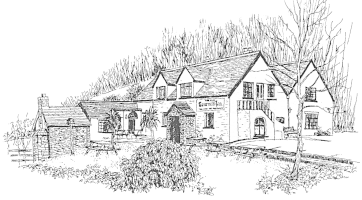
THE OLD SAWMILL INN & YE OLDE GLOBE
Sawmill:
- We shall be open all day from 12.00 noon every day until 31 st August [incl.Carvery available every Sunday Lunch plus Wednesday night through until September.
- Monday nights through summer, 'Balloon Modelling Show', 7.30 p.m.
- Look out for New Real Ales Guesting from The Big Sheep.
Globe:
- Open all day on Saturdays and Sundays, from 12.00 noon. Cream Teas served through August during afternoon.
- Quiz Nights start again late September or early October - date to be confirmed. Quiz Nights will run fortnightly alternating with a 'Games Night' with teams playing 'Killer' at pool, skittles and darts.
We hope you all have a good summer. See you soon.
Thank you to Karen, Wayne, Carl and Edith and the staff at The Sawmill for organising the food and entertainment, and for all their hard work for my 70th Birthday Celebration in May. Also thank you to all my family and friends for coming and providing such a great atmosphere. And, of course, thank you to the two bouncers [Derek and Mitch] for keeping order at the door!
John Clark
Ron would like to thank everyone who joined in the 'Surprise Party' at The Globe to celebrate his 87th Birthday on the 15th July. Especial thanks to Edith, Carl, Karen and the staff, and 'regulars' at The Globe.
30
POSTCARD FROM
POTMAN
by e-mail from Derek
Cooper
I'm sorry that I couldn't stay
I got fed up of clotted cream and I thought I'd have a change of scene.
So I hitched a ride on an old mini-bus
but don't worry none, I don't want no fuss
I arrived here in Lancashire on Sunday at dusk
and I sampled the hotpot with its thick juicy crust.
I'm sorry to tell you that I won't be back
I've met a pot babe to share my sack
I'll write to you folks soon with my new address
PS tell Miss Muffet I'm sorry I left my room in a mess.

31
LOCAL WALK - 79
'A Far Cry from Dartford'
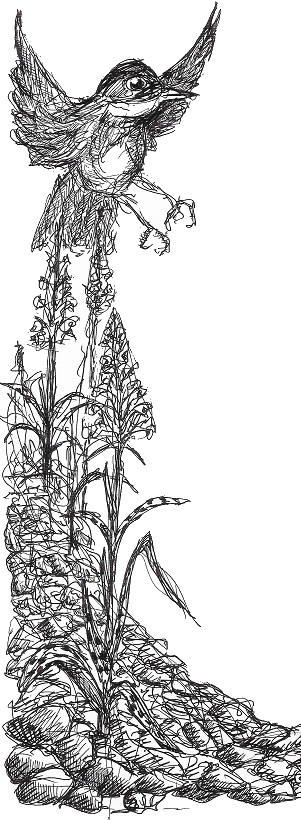
It was a lovely June day, sunny but with a soft sea breeze and we were climbing up the steep slope from Highveer Point, to reach the broad track above, when we heard an unfamiliar scolding noise - metallic and rattling. We traced the sound to some gorse bushes where a small bird was bobbing in and out. It had a slate grey head with crown slightly raised; a dark grey-brown back and dull purplish red front. It cocked its long tail at a jaunty angle and its eyes appeared very large and prominent, this impression being created by a red ring around the eye.
We were delighted! A Dartford Warbler is not a common sight. Its stronghold is the heathland of Dorset. Several of the people we met along the way had set themselves the task of walking ambitious portions of the South West Coast Path. At Highveer Point an Australian backpacker asked us to take his photograph, with Lee Abbey as a backdrop and Foreland Point beyond. He had walked from Porlock and was very impressed by the beauty of Woody Bay and Lynmouth. Highveer Point falls away almost vertically to the sea far below and remarkably, a few sheep were grazing among the rocky outcrops.
Earlier a lizard had crossed the narrow path above Wringpeak. A few heath spotted orchids were growing near the waterfall; white flowers with small crimson dots and spotted leaves. They like a damp, acid situation and are closely related to the common spotted orchid but far less frequent in the South West. In places the covering of heather and gorse gives way to scree slopes consisting of angular fragments of stone. The depth and instability of the scree prevents soil accumulating so that plants cannot become established.
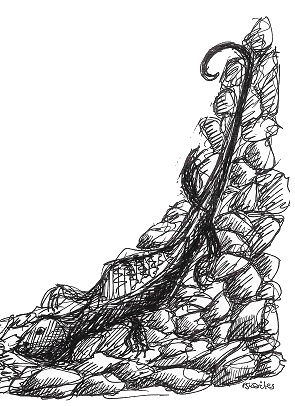
As we reached the higher path we could look down on the sea birds wheeling out from cliff ledges hidden from view. Rafts of guillemots and razorbills were on the water. This is North Devon's most significant sea bird colony. The birds have been helped by the geology of the area.
Where the rock strata are nearly vertical and there are frequent rock falls, there is a lack of secure ledges for nesting. But around Woody Bay the layers of rock dip gently backwards and weather readily into a series of ledges, providing ideal nesting sites. The fulmars first arrived at Woody Bay in 1955 and kittiwake began to breed there in 1970.
There were a lot of Painted Lady butterflies -a black and white chequered pattern on a pale orange or salmon pink background. Even their Latin name is pretty, Cynthia cardui. They are migratory butterflies which spend the winter in North Africa. They have a powerful flight and are seen especially along the coasts and on heaths. The numbers arriving here each year vary but 1996 was an exceptional year for the Painted Lady when large flocks of them invaded gardens.
The return stretch of our circular walk took us around the Hollow Brook gorge; lush and verdant, full of flowers and shrubs - a great contrast to those arid scree slopes but both full of drama in their different ways.
This higher path is wide as coast paths go, because it was originally the old coach road between Woody Bay and Hunter's Inn. What a hair raising journey that must have been!
Sue H
32
H. HUGHES RICHARDSON
Tom's appeal for information on the artist of the watercolour postcards, featured on the covers of the June issue, sent me to look to see if there was anything on the internet. I was delighted, therefore, to be able to make contact with his grandson, Lt. Col. John H Richardson, MBE, who kindly replied to my e-mail telling me that he was researching his grandfather's life, mainly his paintings, with a view to giving, in due course, a postcard size index to the Witt Library of British Painters. Contact with the Salmon Postcard Society showed only four cards illustrating his grandfather's work, and they were the four featuring cottages in Berrynarbor.

Herbert Henry Richardson was born on the 16th December 1882, son of Herbert William Richardson and his wife Sarah Emily [nee Hughes - a Staffordshire family]. They were a tailoring family, like their parents before them.
At the age of 12, Herbert joined the Worcester Porcelain Factory as a flower painter under the tuition of Charles Baldwin and Frank Roberts. Up to the age of 20, he also attended Worcester College of Art. The family moved to the Welsh coal mining area of Risca, where tailoring would have flourished, particularly in the 'Chapel' society to which they belonged.
Herbert met and married Kate Marion Hughes [a real Welsh Hughes this time!] on the 25th January 1908, with much family dissention on her side. After raising three children in Risca and trying employment in mining, insurance and office work, Herbert decided to move to England and earn a living at painting.
From this time on he signed his work 'H. Hughes Richardson' and painted some very prominent families. He served in World War I and during this period and up to 1927, Kate bore him five more children, thus he was now having to support a family of ten.
At the outbreak of World War II, the family moved to Dorset, where later my father- Lynn Hughes Richards - met my mother. However, Herbert would not move with them, returning to Wales and then the Midlands to carry out war work. Kate died in Dorset in 1949.
Herbert never ever met his family again, although he kept in touch with two of his sons who helped him out during the late 1940's and 1950's, when he was not earning from his painting. During this period, he repeated much of his previous work. His output was prolific, well over 2,000 watercolours!
In 1960 Herbert remarried and moved to Bournemouth where he lived happily until his death on the 10th April 1964.
John Richardson
My sincere thanks to John for giving us the information about his grandfather.
33
COTTAGE AND ROSES
The picture on the rear cover of the June issue has stimulated interest and intrigue!
The watercolour card was published by Salmon c 1922, entitled 'Cottage and Roses', and Tom says in his article that H. Hughes Richardson may have made use of an earlier Garratt postcard view c1904 [No. 38] to paint his picture.
Looking closer at the picture, this could well be the case, for with the exception of the bearded gentleman, the pictures are identical, even to the plants growing in the wall and the outline of the trees in the background.



The postcard [No. 37] with the two little girls [reproduced in Tom's June article] was obviously taken at a different time of year since the roses are not in bloom and the trees are leafless. Speculation as to the actual location of the cottage has also been rife, with various suggestions being made.
In his article, Tom says that he believes it is near the bottom of Hagginton Hill, although at one time he was sure it was Whitecote, 33 Pitt Hill. Some agree with this still, whilst others have different ideas.
Congratulations to the Editor for the June issue No. 84, the colour photographs were lovely and caused considerable interest in our household, as the back cover did look remarkably like Devon Cottage, which is our home on Hagginton Hill.
As years have gone by, many changes have been made. The wall has been built up and is now covered in ivy, but the wall in the small postcard picture [reproduced above] to the right is still in place, as are the steps - or were they used as a mounting block? as there is a small stable which is out of the picture.
The lean-to at the southern end of the cottage still remains and is now our kitchen, but we do think at some time in the past small animals were kept there.
Some artistic licence may have been used as the pink roses in the picture show, because I have tried to plant the same thing without success as there is no earth to use, only hard rock. It would be lovely to have roses round the door to make the cottage complete, but roses don't like containers - any suggestions?
Finally, when we showed our American friends the stable, they sent back a card from Berrynarbor to the States telling their daughter that one of the rooms in Devon Cottage had a dirt floor!
Linda Brown - Devon Cottage
The cottage on the front cover of the last issue of the Newsletter is 29 Henton Hill, the first cottage at the bottom of the hill.
James Richards built it on a 99-year lease agreement with Squire Bassett, in the years before 1821 when he married Mary Draper of Moules Farm. James took over the tenancy of Moules about 1840, leaving the cottage free for his eldest son, Benjamin Richards, who married Mary Ann Dyer, the miller's daughter, in 1843.
The cycle repeated itself when Benjamin's eldest son Richard Dyer Richards took up residence with his new bride, Elizabeth Pile, in 1868, following Ben's move to Hammonds Farm. And so it would probably have gone on, but tragically Richard died in 1875, at the age of 26 years, from pneumonia following a soaking in the fields.
Elizabeth was left a widow, with four young children and a baby on the way. "Granny" Richards lived in the cottage until the lease ran out and it was sold by the Estate. She died in 1936 aged 89 years. They were my great-grandparents whom I share with Johnny Huxtable and Bet Brooks.
We have always understood that the second cottage - on the rear cover - is Whitecote, and the old man siting on the wall was Will Richards. If it is Whitecote, the children in the other view would be the Toms children who were photographed playing 'oranges and lemons' on Henton Hill where they lived prior to this time.

Pastel drawing of Richard Dyer-Richards probably done after his death from a photo of his wedding in 1868.

A wedding photo of Granny Richards 1868.

Granny Richards c1876/7 with Richard, Polly, Ernest and Benjamin

An early postcard view of cottages on Henton Hill
Lorna Bowden
My thanks to Lorna for including these lovely old photographs. Due to age they do not reproduce well and apologies to readers if the quality is poor.
34

RURAL REFLECTIONS - 13
In recent articles I have written about the many property programmes that appear on television these days. Some, it seems, feature house hunters in their search for new abodes that are within the realm of our own shores; others take their home seekers further afield. Watching these programmes from a rural perspective, I am always intrigued by the latter, especially if they are seeking a property which is situated in a hot, dry climate.
Of course, there are some quite understandable reasons why people choose to either live or holiday abroad. One obvious explanation is our unpredictable and unforgiving weather. For many, the choice to either melt in Malta or be marooned in Martinhoe is an easy one to make though the chances of the latter are pretty remote, if you think about it.
However, like anything good in life, it comes with its sacrifices; and to be in an area that guarantees you hot, dry weather, the sacrifice is usually the view. Or to be more specific, the possibility of any variation in colour or contrast within that view. Worse still, a local excursion to vary the view can sometimes prove to be a fruitless exercise.
The same, however, cannot be said of the British Isles. Each country, region or indeed each county, seems able to boast some sort of rural splendour that cannot be associated with its neighbours. Obvious examples spring to mind: Yorkshire can boast the Dales, Norfolk the Broads, Worcestershire the Malverns, Derbyshire the Peak District, and there are many others.
A true appreciation of this fact can perhaps only be experienced by travelling any particular length or breadth of the British mainland, a journey I myself recently undertook when visiting family and friends.
Initially we criss-crossed the Garden of England, Kent. Here was a county full of diversity. In places its border meets the sea at its own level, whilst at other times rises high above it, creating those most famous wartime cliffs. In places the county has a clay soil, most prolific in the great marsh at Romney. Yet where the North Downs give birth and begins its march westwards, the ground is chalky.
At Westerham we crossed into Kent's north westerly neighbour, Surrey. By now, the North Downs had risen to a formidable height, 900 feet above sea level at its peak. To the north of the Downs, the county is scattered with commons and the gentler downs such as Banstead, Epsom and Walton. At its north-eastern fringes, the Thames gently meanders through Chertsey before gathering pace as it enters the capital. To the south of the Downs the ground is more level but awash with trees; indeed, Surrey's boast is being one of the heavily wooded counties in England.
Yet Surrey's southerly neighbour is different again. Crossing the border into Sussex's unique Weald, one is aware that trees are on the decrease and the hedgerows widening. Indeed, by the time we met the

Illustrated by: Peter Rothwell
South Downs north of Brighton, the only apparent similarity between it and the North Downs is that they are both ranges of hills; for whilst the North Downs has woodland clinging to its sides, the South Downs is, in many places, bare, its forests stripped a thousand seasons past when wood or farming were the greatest needs. Likewise, there is evidence in places of long-gone hedgerows ripped up to make way to the economical needs of arable farming. Sussex, of course, sidles up against the English Channel, its coastline meeting major rivers at Rye, Newhaven, Shoreham and Littlehampton. Where the River Cuckmere flows out to sea, the shoreline rises steeply and then descends, this occurring seven times and so giving Sussex the unique coastal hills that are aptly named The Seven Sisters.
Crossing the border into Hampshire we were soon in the midst of that county's unique claim to fame: the New Forest, Here, the animal kingdom often takes priority - if a New Forest pony wishes to stop in the middle of the road to take in the view, then man must wait. The ponies are, of course, just one aspect of the Forest's many splendid features.
Despite its name, the New Forest has large areas that are treeless. Yet heading out of Hampshire, its north-western neighbour seems stripped of them. Wiltshire's boast is its Salisbury Plain, offering the ideal location for the claustrophobic. Here, tractors plough their way across wide, open fields. Or where rape seed is allowed to grow, the panorama becomes splattered with huge yellow blotches.
To some, the Wiltshire landscape may seem harsh and unforgiving. If so, then a simple cross into neighbouring Somerset offers yet another change, to softer scenery. Soon we were amongst The Levels, where hedgerows and streams are once again more commonplace. Not that it is level for long, for not too far away are the hills of the Mendips, the Quantocks, the Blackdown Hills and, of course, Exmoor. Here and there we see smaller, isolated hilltops that are full of our ancestral past. If it's landscaped history you're after, Somerset's your county.
Then finally we crossed the border into Devon. Red soil amongst patchwork-quilt fields; rolling hills that create endless valleys, which in turn create an abundance of streams and rivers. Moorland, woodland, the list is endless - but then when it comes to Devon, I am somewhat biased. So, too, am I biased towards our British countryside over foreign lands - as if you hadn't noticed!
Steve McCarthy
35
"THE HAPPIEST DAYS OF YOUR LIFE"
By popular request, following the interest shown in his article about 'Life on the Farm' in the June Newsletter, Ron tells us more of his memories, and in particular his days at Berrynarbor School.
When I started school there were no flush toilets. There were two partitions - one for the girls and one for the boys - and no peeping! There was just a seat to sit on with the stream running underneath. Soft toilet tissue? Not in those days! We used to cut newspaper up into squares and they were hung up on the door by a nail. Fortunately, the papers were rather softer than today's. We were only allowed to go out to the toilet one at a time.
The only heating was a tortoise stove which burnt coke. It had a guard around it and if anyone got wet coming to school, their clothes would be put over the guard to dry and the nailed boots that both the boys and the girls wore, would be put by the stove to dry out. This applied especially to the pupils, 5 boys and 4 girls, who walked from Berry Down. On rainy days, the room would become steamed up and smell of drying clothes, which would often be put back on still damp!
The lunch hour was from 12.00 to 1.00 and there were no hot dinners. The children living near would go home for their meal, and the others would bring sandwiches and stay in school. I had a mate called Fred Spear, who came from Berry Down, and he would come to have lunch with me.
There were three classrooms - one for the girls, one for the boys and one for the infants. Miss Veale, the Headmistress, lived on the corner opposite the church steps - Little Gables - and she taught the boys. Miss Balkwill taught the girls and Miss Lily Richards - mother of John Huxtable and Betty Brooks took the infants. After Miss Balkwill left, Miss Muriel Richards - sister of Lorna Price - took over and taught reading and writing.
We used to write on slates with chalk and there was a blackboard on an easel. Later we had pens and inkwells. No biros or fountain pens then. We used to sit two to a desk, with the girls separate from the boys. The cane was used in those days, usually on your hand but sometimes on your bottom! I was no angel and got caned on many occasions!
Sometimes we would have to stay behind after school and write lines.



We had fun, but like all boys we would fight - with our fists - and egg each other on. The girls would watch, but I never saw them fight. There was a swing in the playground but unlike today, when the ground underneath is of soft material, it was hard and we often hurt ourselves.
Every morning we would have a hymn and once a week the Reverend Churchill would come to take prayers and scripture lessons. I remember that he had a motorbike which had to be started by pushing it and running alongside it, and when the engine got going, he would jump on.
Lessons included the normal things like Maths, History and Geography, and also Gardening. The school garden was divided into 5 plots - each gardened by two boys, one of whom was called 'Head' gardener. The girls tended to the flower borders around the edge.
On Friday afternoons we were allowed to take it easy - read our books or do as we liked, within reason and the classroom.
Music was an option that individual children could enjoy and Miss Earl came one half day a week to take piano lessons. Miss Earl lodged with my mother at 23 Henton Hill and she taught private piano lessons there in the evenings.
Going back to my previous article and work on the farm, in the early days it was seven days a week, but after Gladys and I were married, I had a half day off on Saturdays and one week's holiday a year - sometimes two!
I think that the furthest I have ever been from Berrynarbor was to Wembley, where we were married. Ours was a 'holiday romance' and people said it wouldn't last. But it did, for 58 years! We had our differences, as everyone does, but they always passed over quickly. Gladys died at the age of 85 and our son, Raymond, when he was 56.
But life has to go on. l have a very good daughter, Sheila, son-in-law Tony and two grandsons, Craig and Darren. I also have a lot of very good friends and neighbours, so I think I have a lot to be thankful for.
Ron
The photos of Gladys and myself were taken before we were married and the little bell was the very one that people rang when they called for tea at Middle Lee.
36
CHOOSING THEIR NAMES
Thomas Hood 1799-1845
What do you think their names should be?
One is tabby with emerald eyes,
And a tail that's long and slender,
And into a temper she quickly flies
If you ever by chance offend her.
I think we shall call her this -
I think we shall call her that -
Now, don't you think that Pepperpot
Is a nice name for a cat?
One is black with a frill of white,
And her feet are all white fur,
If you stroke her she carries her tail upright
And quickly begins to purr.
I think we shall call her this -
I think we shall call her that -
Now, don't you think that Sootikin
Is a nice name for a cat?
One is a tortoiseshell yellow and black,
With plenty of white about him;
If you tease him, at once he sets up his back,
He's a quarrelsome one, ne'er doubt him.
I think we shall call him this -
I think we shall call him that -
Now, don't you think that Scratchaway
Is a nice name for a cat?
Our old cat has kittens three
And I fancy these their names will be:
Pepperpot, Sootikin, Scratchaway - there!
Were ever kittens with these to compare?
And we call the old mother
Now, what do you think? -
Tabitha Longclaws Tiddley Wink.

Illustrated by: Debbie Rigler Cook
37
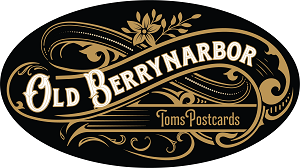
OLD BERRYNARBOR
The Harbour Watermouth - View No. 84
The first and older postcard view of Watermouth was published by the Pictorial Stationery Company Limited of London in 1904 and printed in Hamburg, Germany, under their 'Peacock Brand' label. It shows a very calm high tide with two or three small dinghy-type boats as well as a sailor and a number of children looking out to sea. The Martello-shaped tower can be seen on the right of the picture. The wooden slat type screen is probably the remains of 'Squire' Arthur Davie Bassett's attempt at oyster breeding in the harbour. Indeed, we are informed by the North Devon Journal on the 12th May 1870:
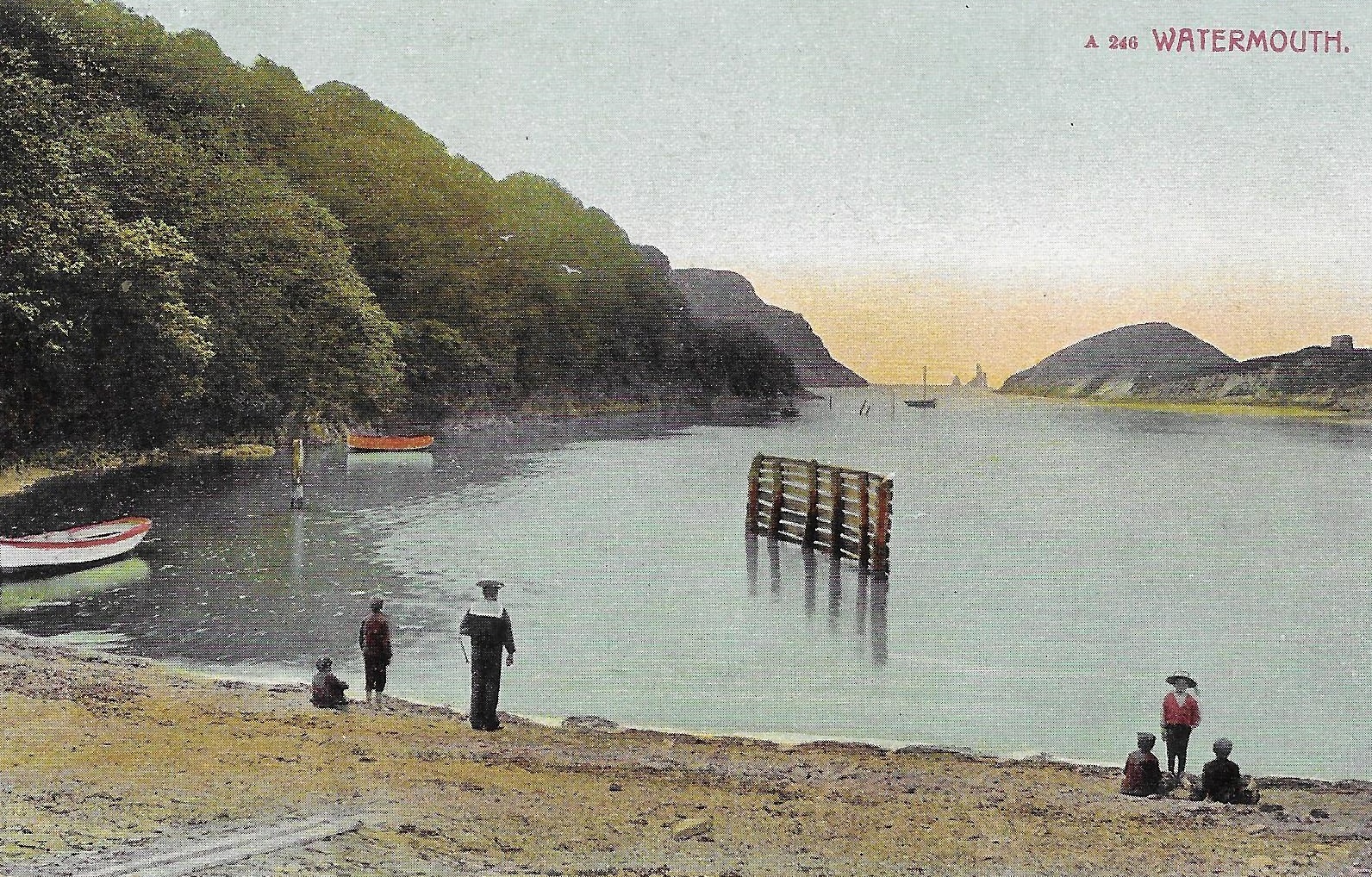
"The year or two since Mr. Arthur Davie Bassett, of Watermouth Castle, resolved to try the experiment of breeding oysters in North Devon. With this view he constructed a large reservoir on the sea beach as an oyster bed, communicating with the sea by means of a canal, and in such manner that the water might be kept in or let out at low tide by use of traps. A number of the small, ovate, deep shell variety of oyster, generally known as "natives" were then procured and placed in the artificial bed. Mr. Bassett found considerable difficulty at first in keeping the bed in good order, and many persons were somewhat incredulous as to the success of the experiment; but, after a great deal of perseverance, the attempt to make a spawning bed has been attended with the most interesting results.
"A quantity of broken pots and similar articles were placed in the reservoir, and on these the "natives" have deposited their spat, which has gradually arrived at maturity. Breeding is now going on to a remarkable extent. Mr. Bassett has kindly forwarded to us some specimens in their various stages of their development, from the minute "spat" to the full grown oyster of four or five years old, anyone feeling an interest on the subject, may inspect them at the Office of the Journal."
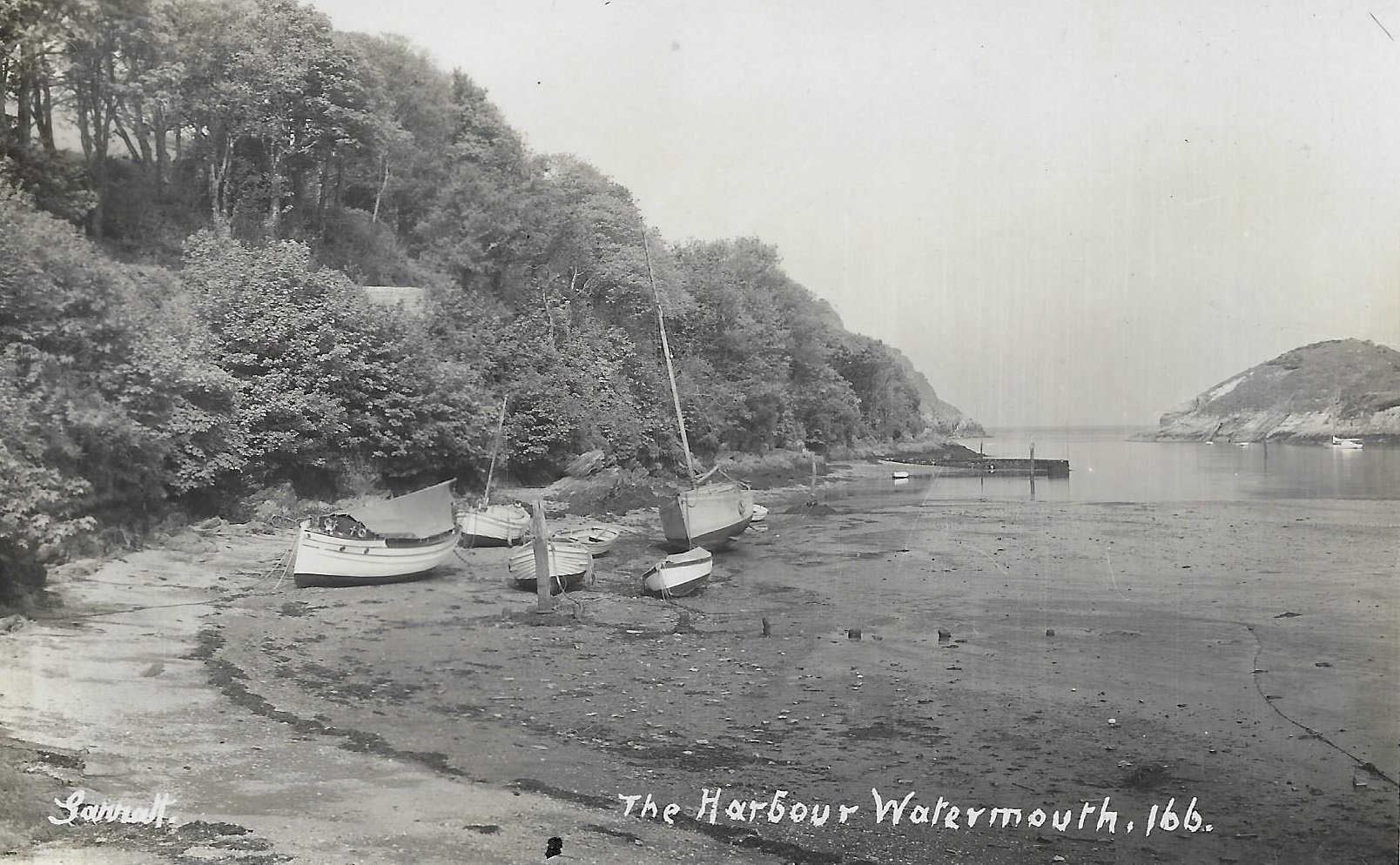
The second picture is a real photographic picture taken around 1936 by the Bristol photographer W. Garratt and is numbered 166. Looking above the collection of small boats, the retaining wall for the main road to llfracombe can be plainly seem, the road itself had been constructed in the late 1800's. Taken midway between high and low tide, the picture plainly shows the small jetty-like breakwater with water lapping it on both sides. During the Second World War the harbour became a hive of activity with PLUTO, leading up to D-Day, but more of this in the October issue.
Tom Bartlett
Tower Cottage, July 2003
e-mail: tomandinge40@gmail.com.
My thanks to our Editor, Judie, who took up my challenge and found out all about H.Hughes Richardson and put me in touch with his grandson, John.
38
AT-A-GLANCE DIARY
| AUGUST | |
| 6th | Bikers of Berrynarbor: Evening Run, 6.00 p.m. at Rear of Globe |
| 12th | St. Peter's Church Fayre, Manor Hall, 6.30 p.m. |
| 13th | Mobile Library in Village from 11.30 a.m. |
| 16th | & 17th 2-Day International European Scramble Championship, Sloley Park, 12.30 p.m. onwards each day |
| 23rd | & 24th Dreamwalk, Castle Hill, Filleigh, in support of the North Devon Hospice |
| 27th | Mobile Library in Village from 11.30 a.m. Friendship Lunch, The Globe, 12.30 p.m. |
| SEPTEMBER | |
| 2nd | W.I. Meeting: Manor Hall, 2.30 p.m. 'My Canadian Experience' Doreen Prater. Everyone welcome. |
| 6th | Horticultural and Craft Show, Manor Hall, 2.00 p.m. |
| 9th | Parish Council Meeting - Manor Hall, 7.30 p.m. |
| 10th | Mobile Library in Village from 11.30 a.m. Bikers of Berrynarbor: Evening Ride, 6.00 p.m. Rear of The Globe |
| 24th | Mobile Library in Village from 11.30 a.m. Friendship Lunch, The Globe, 12.30 p.m. |
| 26th | World's Biggest Coffee Morning, The Globe 9.00 to 11.30 a.m. |
| 28th | St. Peter's Church: Harvest Festival Service |
| OCTOBER | |
| 1st | Trans-send: The Lantern, llfracombe, 7.15 p.m. - "Hemp" St. Peter's Church: Harvest Festival Supper, Manor Hall |
| 7th | W.I. Meeting : 2.30 p.m., Manor Hall |
Manor Hall Diary:
| Mondays | Badminton, 7.30 p.m. |
|---|---|
| Tuesdays | 2nd & 4th in month: N.D.Spinners Yoga, 7.00 p.m. |
| Thursdays | Whist Drive, 7.30 p.m. |
| Fridays | Short Mat Bowls, 7.00 p.m. |
| Sundays | Short Mat Bowls, 2.00 p.m. |
Mobile Library:
(Assistant - Jacqui Mackenzie)
| 11.30 - 11.45 a.m. | Sandy Cove |
|---|---|
| 11.50 - 12.05 p.m. | Barton Lane |
| 1.15 - 1.40 p.m. | The Square |
| 1.45 - 2.05 p.m. | Sterridge Valley |
39
